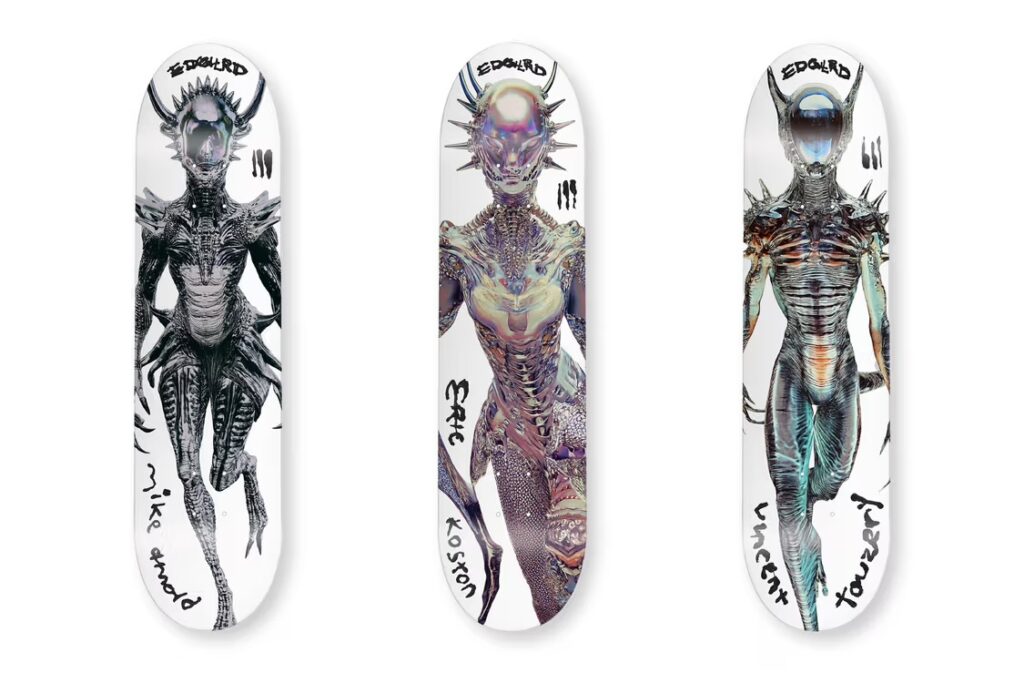When EDGLRD, the avant-garde skate and design collective spearheaded by the enigmatic Harmony Korine, unveiled its FLEXRX deck series, it did more than release new boards. It extended an invitation — one to step further into a dreamlike, alien universe where skateboarding transcends utility and becomes mythology. Featuring collaborations with Mike Arnold, Eric Koston, Elijah Odom, Sean Pablo, and Vincent Tourzery, the series is a celebration of both the sport’s rebellious roots and its infinite creative future.
Gone are the infernal horned figures of AGGRO DR1FT and BABY INVASION. In their place, FLEXRX introduces chrome-clad entities that feel simultaneously seductive and ominous — less hellish monsters, more visitors from a dimension just beyond human comprehension. Each board, constructed from North American Hard Rock Maple, merges high-performance durability with high-concept visual storytelling, solidifying EDGLRD’s position at the crux of skate culture, outsider art, and speculative design.
In the world EDGLRD continues to build, decks are not simply tools. They are vessels. They are talismans. They are canvases for personal and collective transformation.
The Vision: Harmony Korine’s Otherworldly Skate Aesthetic
Harmony Korine’s imprint on EDGLRD is unmistakable. Known for his subversive films like Gummo, Spring Breakers, and The Beach Bum, Korine has always inhabited spaces where chaos and poetry intermingle. EDGLRD represents a natural evolution of his vision — a platform where skateboarding becomes a medium for the surreal and the psychedelic.
With FLEXRX, Korine turns his gaze skyward — but not toward the bright optimism of traditional sci-fi. These aliens are not sanitized or technocratic. They are gleaming and grotesque, chrome-plated echoes of both aspiration and menace. They are beautiful precisely because they refuse to fit conventional models of beauty.
Each FLEXRX board feels like a transmission intercepted from a parallel Earth where skateboarding evolved alongside mythmaking. The boards are kinetic sculptures, designed to be scarred, scuffed, and eventually destroyed in acts of radical, joyful use.
In the tension between their ethereal imagery and their terrestrial function, the FLEXRX decks embody the heart of EDGLRD’s ethos: transcendence through engagement, art not as precious object but as lived experience.
The Flow: Legends and Rising Forces
The FLEXRX series achieves even greater impact through its carefully curated collaborators — a cross-section of skateboarding’s past, present, and near-future.
Eric Koston, often cited as one of the greatest to ever step on a board, lends his name to a deck that feels like a reverent nod to mastery itself. Koston’s style — effortless, innovative, enduring — mirrors the timelessness of the alien creature stamped onto his board: a reminder that true evolution in skateboarding comes not through rejection of the past, but through its expansion.
Mike Arnold, whose fluid, avant-garde approach to skating has made him a favorite among the genre’s experimentalists, brings an organic unpredictability to his design. His creature looks less like a conqueror and more like a fellow traveler — strange, nimble, and endlessly adaptive.
Sean Pablo, a fixture at the intersection of skateboarding and high fashion, offers a deck that embodies romantic rebellion. The chrome figure adorning his board seems to straddle worlds: youthful, defiant, beautiful in its damaged armor.
Elijah Odom, a rising force in contemporary skateboarding, presents a creature that feels both kinetic and embryonic — a being in constant transformation, much like Odom’s own burgeoning style.
Vincent Tourzery, the Parisian skater known for his effortless flow and effortless cool, completes the roster with a board that captures an ethereal detachment — the dreamlike state that true street skating sometimes evokes.
By pairing such a wide array of skaters with his extraterrestrial vision, Korine ensures that FLEXRX resonates across generations and geographies. Each board is personalized, yes — but collectively, they map the contours of a global, evolving skate consciousness.
Material and Craftsmanship: Hard Rock Maple as Mythic Medium
The choice of North American Hard Rock Maple for the FLEXRX decks is not merely a technical specification. It is a continuation of skateboarding’s deep material tradition.
Hard Rock Maple is prized for its combination of resilience and flexibility — two traits essential for both the mechanical demands of skating and the metaphoric demands of art-making. It can absorb impact without shattering. It can warp slightly under pressure but always return to form. It wears its scars proudly.
In the context of FLEXRX, this wood becomes more than a material. It becomes a metaphor. Just as the chrome aliens represent bodies both vulnerable and indestructible, the maple core of each deck embodies a similar paradox: fragility encased in strength, tradition evolving into innovation.
The chrome creatures themselves are cast onto each board with a precision that balances industrial production with artisanal idiosyncrasy. No two boards are truly identical. Each one carries subtle variations — echoes of the human hand that polished the machinery.
Thus, every ride on a FLEXRX deck is not just a journey across concrete. It is a ride through centuries of material wisdom and decades of subcultural rebellion.
From AGGRO DR1FT to FLEXRX: A Shift in Tone
Fans of EDGLRD’s previous projects might recognize FLEXRX as a tonal pivot. Where AGGRO DR1FT reveled in neon-drenched aggression and BABY INVASION explored infantile anarchy, FLEXRX trades violence for seduction, chaos for eerie beauty.
This evolution mirrors broader cultural shifts. In a post-pandemic world increasingly obsessed with survival and reinvention, FLEXRX seems to suggest that evolution — even alien transformation — is no longer a threat but a necessity. The beings on these boards do not invade or conquer. They arrive, they observe, they adapt.
In this way, FLEXRX offers a more hopeful, if still haunting, vision of the future. It suggests that in embracing the alien — the unfamiliar, the uncomfortable, the nonhuman — we might discover new modes of survival, new forms of beauty, and new definitions of community.
Art or Object? Skateboarding as Living Sculpture
One of the enduring tensions surrounding EDGLRD releases is the question: Are these decks meant to be skated, or displayed?
With FLEXRX, Korine and his collaborators seem to offer a characteristically mischievous answer: both, and neither. The boards are beautiful enough to merit display in galleries — their chrome figures gleaming like alien relics under track lighting. Yet they are also designed to be ridden, thrashed, broken, and abandoned.
In this, EDGLRD challenges traditional art-world hierarchies. True value lies not in preservation but in participation. A scuffed, shattered FLEXRX board is not a failed artwork; it is a completed one. The skater becomes co-author. The city becomes canvas. Movement itself becomes sculpture.
This approach reclaims skateboarding’s radical roots. Long before it was a billion-dollar industry, skating was about repurposing dead spaces — empty pools, abandoned lots, forgotten stairwells — into living stages for creativity and rebellion. FLEXRX reminds us that this spirit endures, chrome skins and all.
Impression
With the FLEXRX series, EDGLRD once again bends the arc of skate culture toward the surreal, the speculative, and the sublime. In a time when skateboarding faces unprecedented mainstream acceptance — from Olympic medals to luxury brand endorsements — FLEXRX returns the practice to its wilder, weirder roots.
It celebrates skating not merely as sport or lifestyle, but as mythology — a way of moving through space and time that defies easy categorization. It invites skaters not just to ride, but to transform, to dream, to mutate gloriously beyond the ordinary.
No comments yet.








